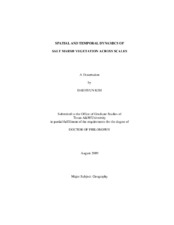| dc.description.abstract | Biogeographic patterns across a landscape are developed by the interplay of environmental processes operating at different spatial and temporal scales. This research investigated dynamics of salt marsh vegetation on the Skallingen salt marsh in Denmark responding to environmental variations at large, medium, and fine scales along both spatial and temporal spectrums.
At the broad scale, this research addressed the importance of wind-induced rise of the sea surface in such biogeographic changes. A new hypothetical chain was suggested: recent trends in the North Atlantic Oscillation index toward its positive phase have led to increased storminess and wind tides on the ocean surface, resulting in increased frequency, duration, and magnitude of submergence and, hence, waterlogging of marsh soils and plants, which has retarded ecological succession.
At the mid-scale, spatial patterns of vegetation and environmental factors were examined across tidal creeks. Sites closer to tidal creeks, compared to marsh interiors, were characterized by the dominance of later-successional species, higher bulk density, and lower nutrient contents and electrical conductivity. This finding implies that locations near creeks have experienced a better drainage condition than the inner marshes, which eventually facilitated the establishment of later-successional plants that are intolerant to physical stress.
At the micro-scale, this research examined how the extent and mode of facilitation and competition vary for different combinations of plant species along physical gradients. Both positive and negative relationships were spatially manifested to a greater degree on the low marsh than on the mid marsh. This insight extends our current knowledge of scale-dependent interactions beyond pioneer zones to higher zones. On the low marsh, different types of bivariate point pattern (i.e., clustered, random, and regular) were observed for different combinations of species even at similar spatial scales. This finding implies that it is difficult to generalize at which scales competition and facilitation occur.
To conclude, this research stresses the need for a holistic approach in future investigations of salt marsh biogeography. For example, based on results of this current research, it would be meaningful to develop a comprehensive simulation model that incorporates salt marsh ecology, geomorphology, and hydrology observed across scales. | en |


